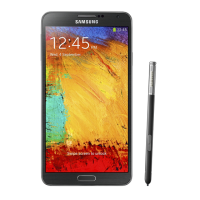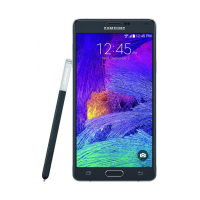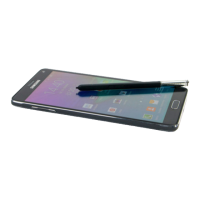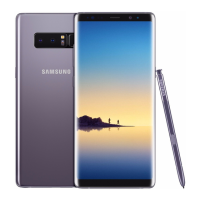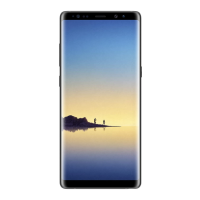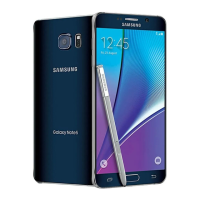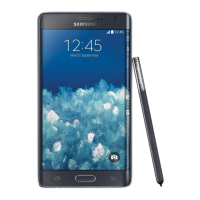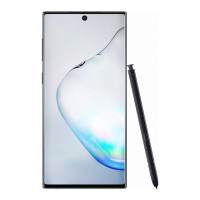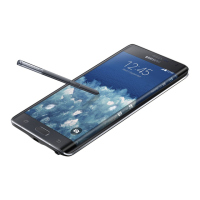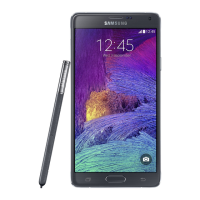Do you have a question about the Samsung SM-N9005 and is the answer not in the manual?
Diagram and labels identifying the device's external components and ports.
Explanation of the functions for the Power, Menu, Home, Back, and Volume buttons.
Details on the S Pen tip and button for basic and advanced actions.
List of items included in the product packaging.
Step-by-step guide for inserting SIM/USIM cards and the battery.
Instructions on how to safely remove the SIM/USIM card and battery.
Procedures for charging the device battery using a charger or computer.
Guide on how to insert a memory card into the device.
Steps to safely remove the memory card from the device.
Instructions for replacing a dull S Pen nib with a new one.
How to turn the device on, off, and use flight mode.
Adjusting volume levels and switching to silent or vibrate mode.
Explanation of common icons displayed on the status bar.
Guidelines for using the touch screen and avoiding damage.
Descriptions of tapping, tapping and holding, dragging, and double-tapping.
How to use flicking and pinching gestures for navigation and zoom.
Using tilting, palm motions, and air gestures for device interaction.
Using the S Pen for selection, capture, and air command features.
Using Action Memo, Scrapbooker, Screen Write, S Finder, and Pen Window.
Using Air view, Smart Pause, and Smart Scroll for enhanced interaction.
Running and managing multiple applications simultaneously on screen.
Managing notifications and accessing quick settings from the status bar.
Adding, moving, and rearranging items on the home screen.
Using widgets on the home and locked screens.
Opening, closing, installing, and uninstalling applications.
Using the Samsung keyboard, voice input, and handwriting.
Connecting to Wi-Fi networks and managing connections.
Setting up and managing Google and Samsung accounts.
Transferring files via USB and connecting with PC software.
Setting up screen lock methods like signature, pattern, PIN, and password.
Updating the device software using Samsung Kies or Over-The-Air.
Making calls using keypad, logs, favorites, and contacts.
Actions during a call: hold, add call, mute, speaker, and merge calls.
Creating, editing, deleting, and organizing contacts.
Sending SMS, MMS, and handwritten messages.
Setting up accounts, sending, and reading emails.
Using the Gmail application for sending and reading emails.
Using Hangouts and ChatON for instant messaging.
Using the Internet application to view webpages and manage bookmarks.
Searching the web and managing tabs using Chrome.
Activating and pairing Bluetooth devices for data exchange.
Sharing the device screen to a large display via Wi-Fi.
Accessing and sharing content from remote devices or web storage.
Enjoying content with friends by sharing and playing together.
Using NFC for reading tags, making payments, and sending data.
Connecting to and controlling a TV with the device.
Listening to music, managing playlists, and setting songs as ringtones.
Taking photos and videos, using shooting modes, and effects.
Creating panoramic photos and recording videos.
Viewing, editing, and organizing images and videos.
Creating digital photo albums automatically from Gallery or tagged photos.
Playing video files, trimming, sharing, and using popup player.
Watching and sharing videos from the YouTube website.
Creating personalized magazines and accessing news content.
Using SketchBook for Galaxy and Bloomberg+ for art and news.
Purchasing and downloading applications and games from the Play Store.
Purchasing and managing digital media content via Samsung Hub.
Purchasing and downloading dedicated Samsung applications.
Using Play Books, Play Movies, Play Music, and Play Games.
Creating, composing, and editing notes with multimedia and sketches.
Making and managing tables and charts with data.
Viewing, editing, and sharing note pages.
Managing events, tasks, and syncing with Google Calendar.
Saving and sharing files using the Dropbox cloud storage.
Syncing files and backing up data with Samsung or Dropbox accounts.
Setting alarms, checking world time, and using stopwatch/timer.
Performing simple and complex calculations.
Monitoring health, tracking steps, exercise, food intake, and comfort level.
Translating text and recording voice memos.
Using voice commands and hands-free operation.
Searching for device content and using Google search.
Creating scrapbooks and searching the web via voice.
Accessing and managing files, folders, and shortcuts.
Viewing downloads and getting travel information via TripAdvisor.
Note-taking and secure device usage.
Using Maps for searching locations and getting directions.
Configuring Wi-Fi, Wi-Fi Direct, Bluetooth, and tethering.
Managing flight mode, data usage, and location services.
Adjusting volume, ringtones, display brightness, and screen modes.
Configuring Multi Window, LED indicators, and lock screen options.
Adjusting settings for improved accessibility, including text-to-speech.
Configuring voice control, hands-free mode, and S Pen options.
Activating one-handed operation and air gestures.
Configuring smart screen features and increasing touch sensitivity.
Managing accounts, cloud sync, and backup/reset options.
Setting date/time and configuring safety assistance features.
Configuring accessory settings and managing applications.
Monitoring battery and managing device storage.
Securing the device with encryption, remote controls, and locks.
Accessing device information and configuring Google features.
Handling prompts for Password, PIN, PUK, and PIN2.
Resolving issues with weak signals, poor reception, and service access.
Troubleshooting a device that does not turn on or charge properly.
Addressing slow response, improper input, or malfunction of the touch screen.
Resolving device freezes, hangs, and fatal errors.
Troubleshooting problems with connecting calls or being heard.
Resolving sound echoes, poor audio quality, and network disconnections.
Addressing rapid battery drain and charging problems.
Troubleshooting camera launch errors and multimedia file playback issues.
Resolving issues with Bluetooth pairing and computer connectivity.
Troubleshooting problems with finding the current device location.
Handling data loss and explaining manufacturing features like small gaps.
| Model | SM-N9005 |
|---|---|
| Display | 5.7 inches, Super AMOLED |
| Resolution | 1080 x 1920 pixels |
| Processor | Qualcomm Snapdragon 800 |
| RAM | 3 GB |
| Expandable Storage | microSD, up to 64 GB |
| Main Camera | 13 MP |
| Front Camera | 2 MP |
| Operating System | Android 4.3 (Jelly Bean), upgradable to 5.0 (Lollipop) |
| Dimensions | 151.2 x 79.2 x 8.3 mm |
| Weight | 168 g |
| SIM | Micro-SIM |
| Network | GSM / HSPA / LTE |
| 2G bands | GSM 850 / 900 / 1800 / 1900 |
| 3G bands | HSDPA 850 / 900 / 1900 / 2100 |
| 4G bands | LTE band 1(2100), 3(1800), 5(850), 7(2600), 8(900), 20(800) |
| Speed | HSPA 42.2/5.76 Mbps, LTE Cat4 150/50 Mbps |
| Protection | Corning Gorilla Glass 3 |
| GPU | Adreno 330 |
| Loudspeaker | Yes |
| 3.5mm jack | Yes |
| WLAN | Wi-Fi 802.11 a/b/g/n/ac, dual-band, Wi-Fi Direct, DLNA, hotspot |
| Bluetooth | 4.0, A2DP, LE, aptX |
| GPS | Yes, with A-GPS, GLONASS |
| NFC | Yes |
| Infrared port | Yes |
| Radio | No |
| USB | microUSB 3.0 (MHL 2), USB Host |
| Talk time | Up to 21 h (3G) |
| Internal Storage | 32 GB |
| Battery | 3200 mAh |
| Sensors | Accelerometer, gyro, proximity, compass, barometer, temperature, humidity, gesture |
| Colors | Black, White |
